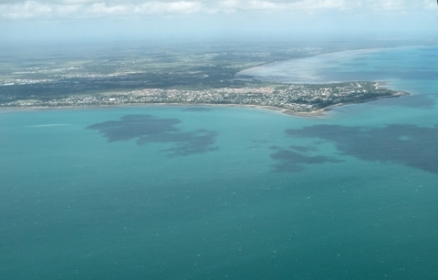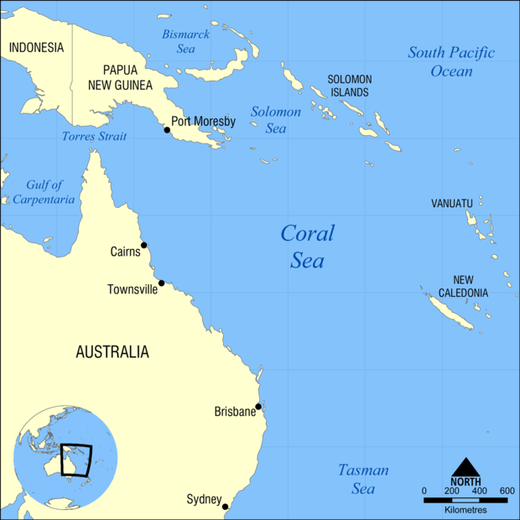Coral Sea
Seas of the World 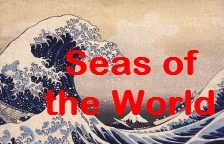 The Coral Sea is a saline marginal sea off the northeastern shoreline of Australia.
The Coral Sea is a saline marginal sea off the northeastern shoreline of Australia.
It is bounded in the west by the eastern coast of Queensland, in the east by the island nation of Vanuatu and New Caledonia, and in the north roughly by the southern extremity of the Solomon Islands. It adjoins the Tasman Sea in the south, with the Solomon Sea in the north and the Pacific Ocean in the east. On the west, it merges with the Arafura Sea through the Torres Strait.
The ecology of the Coral Sea is most notably represented by the Great Barrier Reef, which is immersed in the sea itself. The Coral Sea is known for its origination of violent cyclones that most often may land on the Australian [[coast]line], not only inflicting human damage, but shaping the Forest succession in large areas of Queensland with massive treefall.
Contents
Reefs and Islands
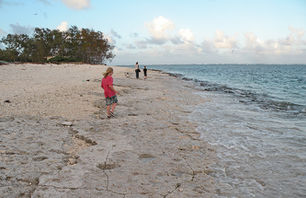 Beach at Lady Elliot Island. @ C.Michael Hogan
Beach at Lady Elliot Island. @ C.Michael Hogan
The most notable and prominent reef feature within the Coral Sea is the Great Barrier Reef, a World Heritage Site and a part of the nation of Australia; this structure, spanning an area of approximately 344,000 square kilometres and made by coral polyps, is the world's most massive object made by living organisms; the Great Barrier reef is actually a collection of almost 3000 individual reefs and about 900 islands. The extent is from Bramble Cay in the north to Lady Elliot Island, the only inhabited island of the Great Barrier Reef, at the south. The other large island/reef assemblage is easterly of the Great Barrier Reef.
Circulation and Hydrography
Surface sea currents in the Coral Sea are influenced by the South Equatorial Current which drives tropical water westward into the Coral Sea between New Caledonia and the Solomon Islands. That surface flow subsequently branches in the vicinity of the Queensland Plateau, somewhat east of the central north Great Barrier Reef. The northward flowing branch manifests a clockwise coastal current and partially closed gyre in the northern part of the Coral Sea, with the northward flow discharging to the Solomon Sea.
Corresponding the southward moving current from the split becomes the East Australian Current. The split point at which the two currents branch varies by season. A portion of the East Australian Current is actually returned northward via an offshore counter-current southerly of the Great Barrier Reef. However, the main portion of the East Australian Current breaks into eddies and meanders along the coast of New South Wales prior to separation from the coast south of the Solitary Islands. The main current thence crosses the Tasman Sea, ultimately returning to the western Pacific Ocean around the north tip of North Island, New Zealand.
Meteorology
The regional meteorology is most noted for the formation of tropical cyclones that originate in the Coral Sea; these same weather systems also form in the Gulf of Carpentaria, Arafura Sea and the Indian Ocean, and often reek havoc on coastal areas with violent winds and torrential flooding. Cyclone landfall most often occurs along the coast of northeast Australia, and may cause major shaping of forest evolution and succession by causing massive areas of tree windthrow.
Ecology of the Great Barrier Reef
See main article: Great Barrier Reef
The Great Barrier Reef comprises mainly Pisonia grandis on Heron and Lady Musgrave islands. Hoskyn Island, with a forest of Pandanus with Pisonia and Ficus apposita, is unique to the group. Vegetation also includes Casuarina, grasses such as Thuorna insula and Lepturus sp., Abutilon indicum, Candia subcordate and Poinsettia sp. A wide range of fleshy algae occurs, many of which are small and inconspicuous but which are highly productive and are heavily grazed by turtles, fish, molluscs and sea urchins. In addition, algae are an important component of reef building processes. Fourteen species of seagrass grow throughout the reef area and are an important food source for grazing animals, although they are rarely abundant. Extensive seagrass beds may be found in inshore waters, providing important grazing for dugongs.
There are over 1500 species of fish, 400 species of coral, 4000 species of mollusc and 242 species of bird within the protected area of the Great Barrier Reef, plus a great diversity of sponges, anemones, marine worms and crustaceans. The site includes major feeding grounds for dugong. Dugong dugon (V). Several cetaceans are present, including Humpback whale, Megaptera novaengliae (E), Northern minke whale,Balaenoptera acutorostrata, and Killer whale Orcinus orca. Dolphins include Bottle nose, Tursiops truncatus, Irrawaddy Orcaella brevirotris (K) and Indo-Pacific humpback Sousa chinensis (Indo-pacific humpbacked dolphin). Offshore, Spinner dolphin,Stennella longirostris, is also occasionally seen. There are nesting grounds of world significance for Green turtle, Chelonia mydas (E), and Loggerhead, Caretta caretta (V), and habitat for four other species of marine turtle.
Terrestrial Margin
See main article: Queensland tropical rainforests ecoregion
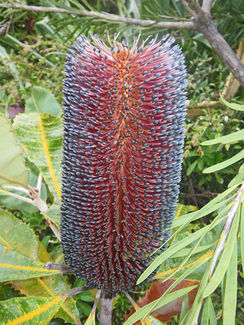 Blooming shrub on Lady Elliot Island. @ C.Michael Hogan The principal terrestrial margin of the Coral Sea is along the northeastern coast of Australia. At this location, theQueensland tropical rainforests contain most of the world’s present day relict species of the ancient Gondwanan forests. The rainforests here contain the most complete and diverse living record of the major stages in the evolutionary history of the word’s land plants, as well as one of the most important living records of the history of the marsupials and the songbirds. High concentrations of endemic monotypic genera and primitive plant families reflect the Refugial nature of many parts of the ecoregion. These rainforests also provide an unparalleled living record of the ecological and evolutionary processes that shaped the flora and fauna of Australiaover the past 415 million years, although the Queensland tropical rainforests are only about as old as 70 million years as a stable time continuous ecological system.
Blooming shrub on Lady Elliot Island. @ C.Michael Hogan The principal terrestrial margin of the Coral Sea is along the northeastern coast of Australia. At this location, theQueensland tropical rainforests contain most of the world’s present day relict species of the ancient Gondwanan forests. The rainforests here contain the most complete and diverse living record of the major stages in the evolutionary history of the word’s land plants, as well as one of the most important living records of the history of the marsupials and the songbirds. High concentrations of endemic monotypic genera and primitive plant families reflect the Refugial nature of many parts of the ecoregion. These rainforests also provide an unparalleled living record of the ecological and evolutionary processes that shaped the flora and fauna of Australiaover the past 415 million years, although the Queensland tropical rainforests are only about as old as 70 million years as a stable time continuous ecological system.
References
- S.Goosem, G. Morgan, and J. E. Kemp. 1999. Wet Tropics. Pages 1-73 in P. S. Sattler, and R. D. Williams, editors. The Conservation Status of Queensland’s Bioregional Ecosystems. Environmental Protection Agency, Brisbane, Australia.
- David Hopley, Scott G.Smithers and Kevin E.Parnell. 2007. The geomorphology of the Great Barrier Reef: development, diversity, and change. Cambridge University Press. ISBN 0521853028.
- Kon-Kee Liu, Larry Atkinson. 2009. Carbon and Nutrient Fluxes in Continental Margins: A Global Synthesis (Google eBook)Springer. 741 pages
- Derek John Mulvaney and Johan Kamminga. 1999. Prehistory of Australia. Smithsonian Institution Press. 480 pages
- John E.Randall, Gerald R.Allen, Roger C. Steene. 1997. Fishes of the Great Barrier Reef and Coral Sea. University of Hawaii Press. 557 pages
